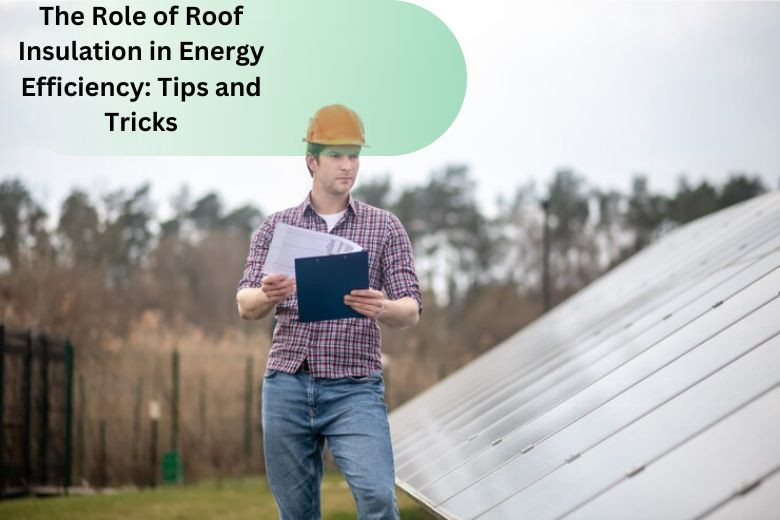The Role of Roof Insulation in Energy Efficiency: Tips and Tricks
Posted on October 02, 2024 by Admin

Every house owner ought to understand how roof insulation works, one of the essential ways through which they can manage to save on energy costs and enhance comfort levels within their home. In other words, it serves as an effective barrier against heat loss/gain and facilitates the interior to acquire and maintain a constant temperature. This would reduce excessive heating or cooling of the home. Here, we will briefly discuss the critical role that roof insulation plays in energy efficiency and will present some DIY tips and tricks on how it can maximize that potential.
Why Roof Insulation is Important
The contribution of roof insulation to energy efficiency cannot be understated. Proper insulation makes a huge difference in the amount of energy spent in heating up or cooling down a house. In the winter, it will retain warm air inside the house and thus reduces the expense of heating. Likewise, in summer, it prevents hot air from entering and thus lowers cooling costs. These are implications that will include creating substantial savings on energy bills with a reduced carbon footprint.
Types of Roof Insulation
There are various roof insulation materials that perform their roles in ensuring energy efficiency. These include:
1. Fiberglass insulation:
This is among the common ones, having the attribute of being pocket-friendly while at the same time having efficient service delivery. It is usually packaged in batts or rolls and is easy to install.
2. Spray Foam Insulation:
The foam foams up, filling gaps and sealing the cracks to air leakage effectively, thereby improving the role of roof insulation in energy efficiency.
3. Reflective or Radiant Barrier Insulation:
The design of this insulation reflects radiant heat from your home and hence is effective, especially in hot climates. This insulation is usually installed in the attic and helps to cut down on cooling costs.

4. Rigid Foam Insulation:
With the high R-value per inch, rigid foam insulation does very well in locations requiring a thin layer of insulation possessing high thermal resistance.
Must Read: Understanding the Roof Installation Process: What Homeowners Should Know
Tips to Maximize the Role of Roof Insulation
For maximum effect on the energy efficiency from roof insulation, consider the following:
1. Selecting the Insulation Material:
The right type of insulation depends on the climate and other factors. Consult a professional to sort out what's best for you.
2. Proper Installation:
It is very important that the roof insulation is installed absolutely perfectly; poorly installed insulation will defeat the purpose by having gaps and air leaks.
3. Seal Air Leaks:
Seal any air leaks around the roof structure before putting in insulation to ensure that it will work effectively.
4. Provide Enough Ventilation:
Proper ventilation of the attic is as important as insulation itself. This prevents moisture from building up and provides an impairment to the effectiveness of insulation.
5. Upgrading Insulation Gains:
If your house has old insulation, try replacing them with the newer and more effective ones. Newer technologies concerning roof insulation have completely changed the role that roof insulation plays with respect to energy efficiency.
6. Periodic Inspections:
Make sure periodic checks over your roof insulation; it has to be in good condition. Check your roof insulation regularly for any damage or wear and tear and take timely action to correct the fault.
Hacks to Boost Energy Efficiency
To further enhance the role of roof insulation in energy efficiency, apply these additional hacks:
Weatherstripping:
Use weatherstripping around doors and windows to prevent air from seeping out. It may further complement your roof insulation.
Energy-Efficient Windows:
Fix energy-efficient windows to block as much heat from escaping and entering to complement your roof insulation.
Smart Thermostats:
Effectively optimize your heating and cooling systems to keep your home energy-friendly throughout the year.
Must Read: How to Prepare Your Roof for Severe Weather
Conclusion
This becomes one of the ways to stay comfortable and cost-effective at home: making sure that there is energy efficiency due to the presence of a roof with insulation. Knowing the types available, coupled with best practices in laying them and taking good care of them, largely helps a homeowner to reduce their energy use and hence slashes the utility bills. The following tips and advice will help you wring out the best value from your roof insulation for a comfortable, energy-efficient, and eco-friendly home.
Also Read :
The Importance of Proper Attic Ventilation for Roof Health
How to Identify and Prevent Roof Mold and Mildew
The Best Practices for Removing Snow from Your Roof
The Role of Roof Decking in Structural Integrity
The Benefits of Cool Roofs in Hot Climates
How to Install a Tankless Water Heater: Pros and Cons
The Benefits of a Home Plumbing Maintenance Plan
Roof Safety Tips for Homeowners
The Impact of Algae and Moss on Your Roof
Faqs
-
1. What kind of roof insulation is most effective in energy efficiency?
Fiberglass, spray foam, reflective barriers, and rigid foam each very efficient type of roof insulation has its benefits toward energy efficiency.
-
2. How does roof insulation help save energy?
Thus, it prevents the loss and gain of heat, which reduces the requirement for both heating and cooling. This reduction was found in research to reduce energy usage a great deal and tends to minimize utility bills as well.
-
3. Can I install roof insulation by myself, or should I hire a professional?
Although some types of insulation, such as fiberglass batts, may be DIY projects, having a professional assures proper installation and maximizes the role that installed roofing insulation will play in ensuring energy efficiency.
-
4. How often should I inspect my roof insulation?
Regular inspections should be done at least once a year, checking for the condition of your insulation against damage, wear, or the development of moisture issues that might alter its efficiency.
-
5. Are there any tricks to enhance the energy efficiency of roof insulation?
It can, therefore, be improved upon by sealing the air leaks, maintaining proper ventilation, and installation of energy-efficient windows and smart thermostats to bring out the best role of roof insulation in energy efficiency.
Recent Post
- Top Plumbing Service Providers in Arizona, USA
- Top 10 Electrician Service Providers in Alabama, USA
- Top 20 Roof Repair Service Providers in Alabama, USA
- The Role of Roof Insulation in Energy Efficiency: Tips and Tricks
- Understanding Roof Damage from Wildlife and How to Prevent It
- How to Choose the Best Roofing Contractor for Emergency Repairs
- Roofing Maintenance for Historic Homes: Preserving Architectural Integrity
- The Importance of Proper Attic Ventilation for Roof Health
- How to Identify and Prevent Roof Mold and Mildew
- The Best Practices for Removing Snow from Your Roof